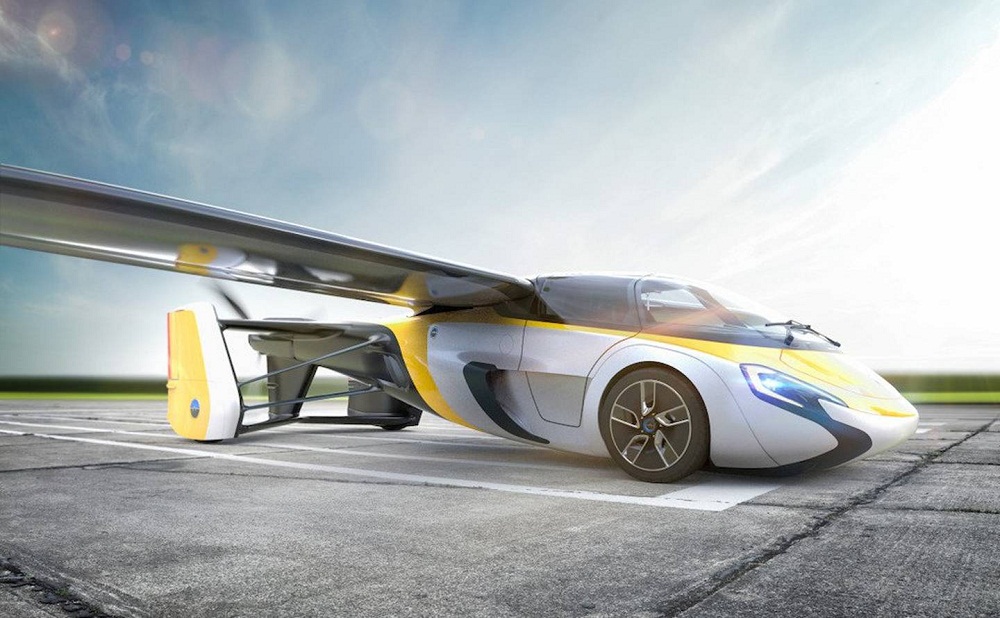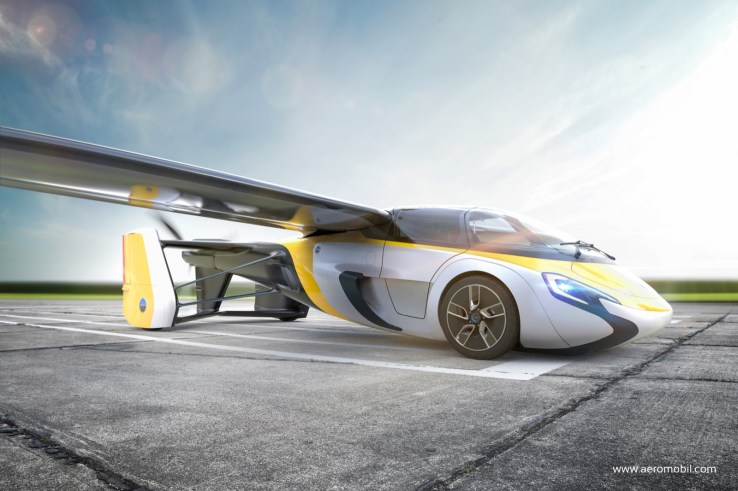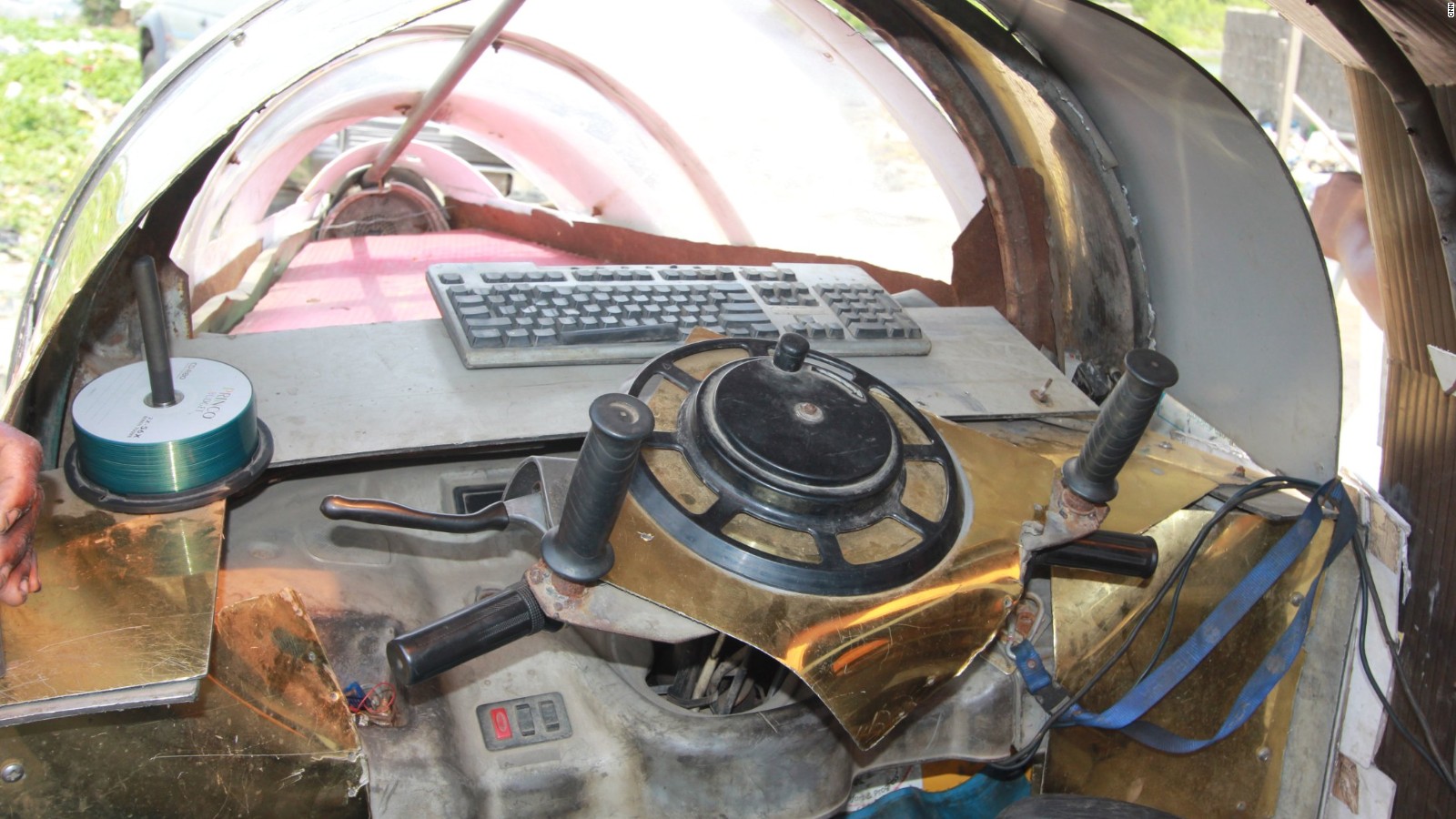Based on the Cormorant, a military craft set to ferry wounded soldiers from the battlefield The development of CityHawk is expected to take five years, and it will be able to run on a range of fuelsSelf flying version also under development to allow five passengers to be carried By Mark Prigg For Dailymail.com
Published: 17:09 EDT, 17 April 2017 | Updated: 17:21 EDT, 17 April 2017
e-mail View comments
While the flying car is yet to become commonplace, an Israeli firm believes its version of the much anticipated transport could seen be ferrying passengers around in the air.
Called the CityHawk, the five seater could be ferrying four passengers using giant jet fuel powered fans.
It is based on the Cormorant, a military craft set to ferry wounded soldiers from the battlefield.
Scroll down for video
The radical design uses enclosed fans, allowing it to land and take off in enclosed spaces. Although initial versions will have a pilot, future craft will be able to fly themselves.
'Metro Skyways Ltd., a subsidiary of Urban Aeronautics plans to launch the design and development of a four-passenger, Vertical-Takeoff and Landing (VTOL), flying car based on Urban Aeronautics' internal rotor, Fan craft™ technology.' the firm said today.
The vehicle will initially be powered by jet fuel, but will be designed from the outset to convert to liquid hydrogen and eventually also to 700 bar compressed hydrogen, once such options become commercially feasible.
'CityHawk is unique in combining a compact, car-sized design that has a four passenger capacity, no exposed rotors or wings, no batteries and potential for zero carbon emissions,' the firm says.
The development of CityHawk is expected to take five years and draws on UrbanAero's experience in developing and flight testing its one ton, unmanned Cormorant that is being developed by the company's second subsidiary, Tactical Robotics Ltd.
CityHawk will be similar to Cormorant in shape and size.
CityHawk will initially be piloted by a human pilot, the technology is being developed and tested on Tactical Robotics' Cormorant prototype which already flies fully autonomously.
Cormorant has so far accumulated in excess of 200 flight tests.
CityHawk's first public demonstration will take place at an airshow shortly after completion of development.
CityHawk will initially be piloted by a human pilot, the technology is being developed and tested on Tactical Robotics' Cormorant prototype whi ch already flies fully autonomously.
As the technology of autonomy and regulatory infrastructure mature, CityHawk will eventually transport passengers robotically.
The hydrogen powered version of the craft will rely on direct feed of hydrogen into a state-of-the art turboshaft engine as an alternative to fuel cells and electric motors.
All CityHawks will be equipped with a standard rocket deployed parachute that will bring them safely down to the ground should any flight critical event occur while airborne.
A flying ambulance has successfully completed its first ever autonomous flight. Dubbed the Cormorant, this vertical take-off and landing (VTOL) aircraft is designed to carry 1,000 pounds every 31 miles, allowing it to deliver suppliers to war zones and carry wounded soldiers to safety
CORMORANT FIGURES
Capacity: 2 patients
Length: 20 ft 4 in (6.2 m)
Width: 11 ft 6 in (3.5 m) , 2.15 m without thrusters
Height: 7 ft 7 in (2.3 m) , 1.8 m without thrusters
Urban Aeronautics is currently talking with potential partners and investors interested in participating in funding the CityHawk project.
Meanwhile work continues on its military brother, the Cormorant.
Dubbed the Cormorant, this vertical take-off and landing (VTOL) aircraft is capable of carrying 1,000 pounds over 31 miles, allowing it to deliver supplies to war zones and carry wounded soldiers to safety.
The craft is also designed to make 'split decisions' if issues should occur during a mission - it either continues its journey, retreats home or lands for further instructions from a human operator.
The prototype has taken two years to complete, but its creators are hopeful that it will be able to reach places traditional helicopters can't in the near future.
The Cormorant was developed by the Israeli firm Tactical Robotics, a subsidiary of the 'Fancraft' technology pioneer Urban Aeronautics, who has conducted more than 200 flights with this military machine.
Its sole purpose is to transport troops, civilian passengers or supplies within tight quarters where helicopters are unable to travel.
This test flight, which was carried out on November 3, was the first time the Cormorant took to the skies over uneven terrain while piloting itself.
Urban Aeronautics' demonstration brings this te chnology one-step closer to assisting soldiers in search and rescue missions, as it is able to access dangerous war zones that are unsafe for humans.
'This flight paves the way forward for the immediate evolution of Cormorant from prototype to near-term production and ultimately commercialization of this groundbreaking technology - for broad applications and markets, said Urban Aeronautics founder Rafi Yoeli.
'This is the most exciting time in the Company's history and we look forward to accelerating our progress now that the technology is fully proven.'
Engineers designed the craft with a Flight Management System (FMS), which lets it to make 'split second decisions' if any of its sensors detect a problem during a mission.
The craft will then make the judgment call on its own - it decides between continuing the journey, retreating home or making an immediate landing to wait for further instructions from a human operator.
The Cormorant was developed the Israeli firm Tactical Robotics, a subsidiary of the 'Fancraft' technology pioneer Urban Aeronautics, who has conducted more than 200 flights with this military machine. This test flight (pictured), which was carried out on November 3, was the first time the Cormorant took to the skies over uneven terrain while piloting itself
WHAT ARE THE FEATURES OF THE CORMORANT?
Has completed about 200 flights with the prototype.
Can carry just a little over 1,000 pounds of cargo.
It can reach speeds of 100 knots (115 mph) and operate at altitudes of up to 18,000 feet.
Features lift rotors that are safely enclosed inside its body and uses duct fans to operate.
Powered by remote control or autonomous control system and it's equipped with rear propellers that enable it to take-off horizontally.
The vehicles are powered by a 730 shp Turbomeca Arriel 1D1 turboshaft and the final versions will use the more powerful ARRIEL 2 variant, capable of providing 985 shp at ta keoff.
Tactical Robotics Ltd hopes the Cormorant will be in the field over the next few years.
Cormorant will be able to deliver supplies day after day and can also be a maritime force multiplier on vessels that are too small for a traditional helicopter, as noted by Defense Update.
'The challenge in designing and testing an FMS for a configuration that is has never been addressed by standard flight control algorithms, is analogous to a novice pilot attempting to fly for the first time with an understanding of basic aerodynamic principles but no instructor,' explained Urban Aeronautics.
The Cormorant is set to replace medivac choppers, like the one from the television show MASH (pictured), in order to reach tight quarters helicopters cannot go
During the test flight, Cormorant's FMS corrected itself in response to unexpected events.
Two instances were related to height above ground over the field (resulting from inaccuracies in laser beam return over uneven terrain and ground conditions).
The third event occurred over the tarmac, which was caused by 'poor judgment' on the part of the Flight Control System (FCS), causing the aircraft to descend too early in its landing approach.
Instead of using traditional propellers, the Cormorant is designed with duct fans that keep the rotors enclosed in a protective shield in case the vehicle hits a wall or any other object in its path, reports LiveScience.
These duct fans enable it to to take-off and land horizontally, and it also has vertical movement that is controlled by internal rotors, which can only be seen from directly above or below.
Engineers designed the craft with a Flight Management System (FMS), which lets it to make 'split second decisions' if any of its sensors detect a problem during a mission. The craft will then make the judgment call on its own - it decides between continuing the journey, retreating home or making an immediate landing to wait for further instructions
However, Urban Aeronautics reveals that the team is working on obstacle avoidance sensors that will keep the vehicle away from oncoming objects, which they hope to add to the vehicle in the near future.
The Cormorant has enough strength to carry 1,000 pounds per 30 miles, which means it can hull about 13,000 pounds in a full day.
The craft flies itself using an array of laser altimeters, radars and sensors, and it is capable of reaching speeds of 100 knots (115 mph) and operate at altitudes of up to 18,000 feet.
It weighs abo ut one-ton and can be operated with a specially made remote control or by using its own autonomous control system.
Two instances were related to height above ground over the field (resulting from inaccuracies in laser beam return over uneven terrain and ground conditions). The third event occurred over the tarmac, which was caused by 'poor judgment' on the part of the Flight Control System (FCS), causing the aircraft to descend too early in its landing approach
Earlier this year, the Cormorant, which was known as the 'AirMule' at the time, hit a milestone that allowed it to successfully complete its autonomous flight.
In January, the craft performed its first ever untethered flight, which it demonstrated a vertical takeoff and landing, followed by stability checks and forward flights at low speeds, reports Defense Update.
'Looking back at a decade of internal rotor VTOL aircraft development at Urban Aeronautics Ltd', said Yoeli regarding the earlier this year.< /p>
'It gives me great satisfaction to see that we are able to transform a dream into a safe and reliable aircraft that is designed to meet manned helicopters safety criteria and absolutely stands up to existing airworthiness standards.'
The craft flies itself using an array of laser altimeters, radars and sensors, and it is capable of reaching speeds of 100 knots (115 mph) and operate at altitudes of up to 18,000 feet. It weighs about one-ton and can be operated with a specially made remote control or by using its own autonomous control system
With the strength of the Cormorant, it will be able to deliver supplies day after day and can also be a maritime force multiplier on vessels that are too small for a traditional helicopter, as noted by Defense Update.
The craft's test flight took place on December 30th at the Megiddo airfield in the northern part of Isra el. Urban Aeronautics is also working on compact, car-sized VTOL aircraft for civilians, called Metro Skyways.
'Metro Skyways is at an early stage of exploring business opportunities that will develop Urban's 'Fancraft' technologies into a family of safe, FAA certifiable personal and commercial, manned VTOL aircraft for the civil market', according to the company.
This model may be the flying cars we have all so desperately hoped for.
Earlier this year, the Cormorant, which was known as the 'AirMule' at the time, hit a milestone that allowed it to successfully complete its autonomous flight. In January, the craft performed its first ever untethered flight, which it demonstrated a vertical takeoff and landing, followed by stability checks and forward flights at low speeds
Source:
Forget Kitty Hawk, commuters could soon be hailing a CityHawk: Four passenger flying car powered by giant fans revealed






 [Photo: Flickr/SDASM Archives] Earthlings On Mars
[Photo: Flickr/SDASM Archives] Earthlings On Mars  [Photo: Flickr user National Archive] The Car Of The Future
[Photo: Flickr user National Archive] The Car Of The Future  [Photo: Flickr user Internet Archive] AI And The Robot Revolution
[Photo: Flickr user Internet Archive] AI And The Robot Revolution 








